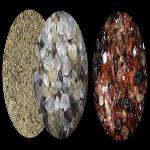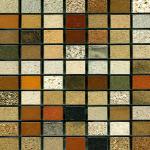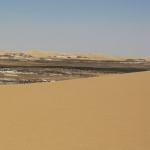15 April 2010

Photo: Michael Welland
Close up, sand grain can appear jewel-like. Indeed, many gems, such as diamonds and sapphires, are made from ancient sands.
Whether at the desert, on the beach or piled up at a construction site, sand is one of the most common, useful and wondrous materials on earth.
But what is sand? Where does it come from? How is it formed and how does it behave?
Never-Ending Story
Those are questions that prompted British geologist Michael Welland to write his book-length ode to the stuff, "Sand: the Never-Ending Story."
"Sand is an apparently mundane everyday material," says Welland, "and yet the journeys an individual sand grain can take you on, both physically and imaginatively, I found extraordinary."

Courtesy: Michael Welland
Geologist Michael Welland collects sand samples in central California.Geologist and physicists long ago decided that what makes sand sand is the size of the individual granular bits, not what they are made of. Welland notes that sand grains differ from other granular materials, both in the way they pile, and in how they behave.
"When they're flowing in the air or flowing in water, for example, they behave very differently from everything that is smaller — that's silt and mud — and everything that is bigger — that's gravel and pebbles and cobbles and boulders."
Welland's book about sand earned him the prestigious John Burroughs Medal for natural history writing, which was presented earlier this month at New York's American Museum of Natural History. He was right at home in that august locale; sand is an important element in the beautiful old building's sparkling pink granite fa?ade.
 'Sand: the Never-Ending Story' has garnered geologist Michael Welland the 2010 John Burroughs Medal for natural history writing.
'Sand: the Never-Ending Story' has garnered geologist Michael Welland the 2010 John Burroughs Medal for natural history writing. A Sand Grain Is Born
"Well, what's sparkling are quartz grains. In a few million years, the granite of the Natural History Museum, exposed to the elements of New York, will begin to rot and disintegrate," says Welland. As the most frail minerals dissolve, "the quartz, which is as tough as old boots, will eventually just drop out as a sand grain."
Some of those quartz sand grains will be washed away by rainwater into nearby rivers where they will make their way down to the shoreline, and the sea or get blown to the desert. In the desert, sand grains are usually buffeted and shaped by the wind, which tends to make them smooth and rounded.
"The sand grains bang into each other," says Welland, "and that force tends to knock the rough edges off a grain." Desert sands are often frosted like sand blasted glass.

Courtesy: Loes Modderman
The beauty and variety of sand is visible in this array from South Africa, arranged by the artist Loes Modderman."But," says Welland "if you go to the beach where the water buffers the impact between grains, it takes millions and millions of years to knock their rough edges off."?
In yet another kind of transformation, grains of coastal sand can get squeezed together by the weight of overlying sediments and become rock themselves, which is how sandstone gets formed.
Welland explains that those sand stones can then be churned back up to the earth's surface by the movement of the earth's plates and then those sandstones themselves will rot.
"And so, the sand grain starts off on a second life journey. Many of the grains we see on the beach will have been through two, three, four, five of those cycles over hundreds of millions of years."??
 British geologist Michael Welland says sand has many uses in the modern world.
British geologist Michael Welland says sand has many uses in the modern world. Sand families
Sand grains tend to group together in "families" according to mineral type, density, shape, weight and other factors. The relative proportion of these groupings in any one area of beach is unique.
Sand can even be used as forensic evidence in criminal investigations. For example, if the specific array of minerals in the sand found in a suspect's shoe match the stretch of beach where a murder victim is found, the owner of that shoe might be wise to call a lawyer.
Welland says sand has so many other uses that the modern world would be unrecognizable without it.
"We wouldn't have any glass or concrete, or the mobile phones or computers we have now — or they would have to work in completely different ways. Much of the world's jewelry would disappear. Sapphires and diamonds, for example, come from ancient deposits of sand [where] rivers have winnowed the minerals away."
"A World in a Grain of Sand..."
In his book "Sand: the Never-Ending Story," Michael Welland says that sand's beauty and diversity are every bit as compelling as its science.
He advises skeptics to bring a magnifying glass next time they go to the beach, grab a handful, and take a close look.
He confidently predicts that, like the mystic British poet William Blake, you'll see "a world in a grain of sand."?